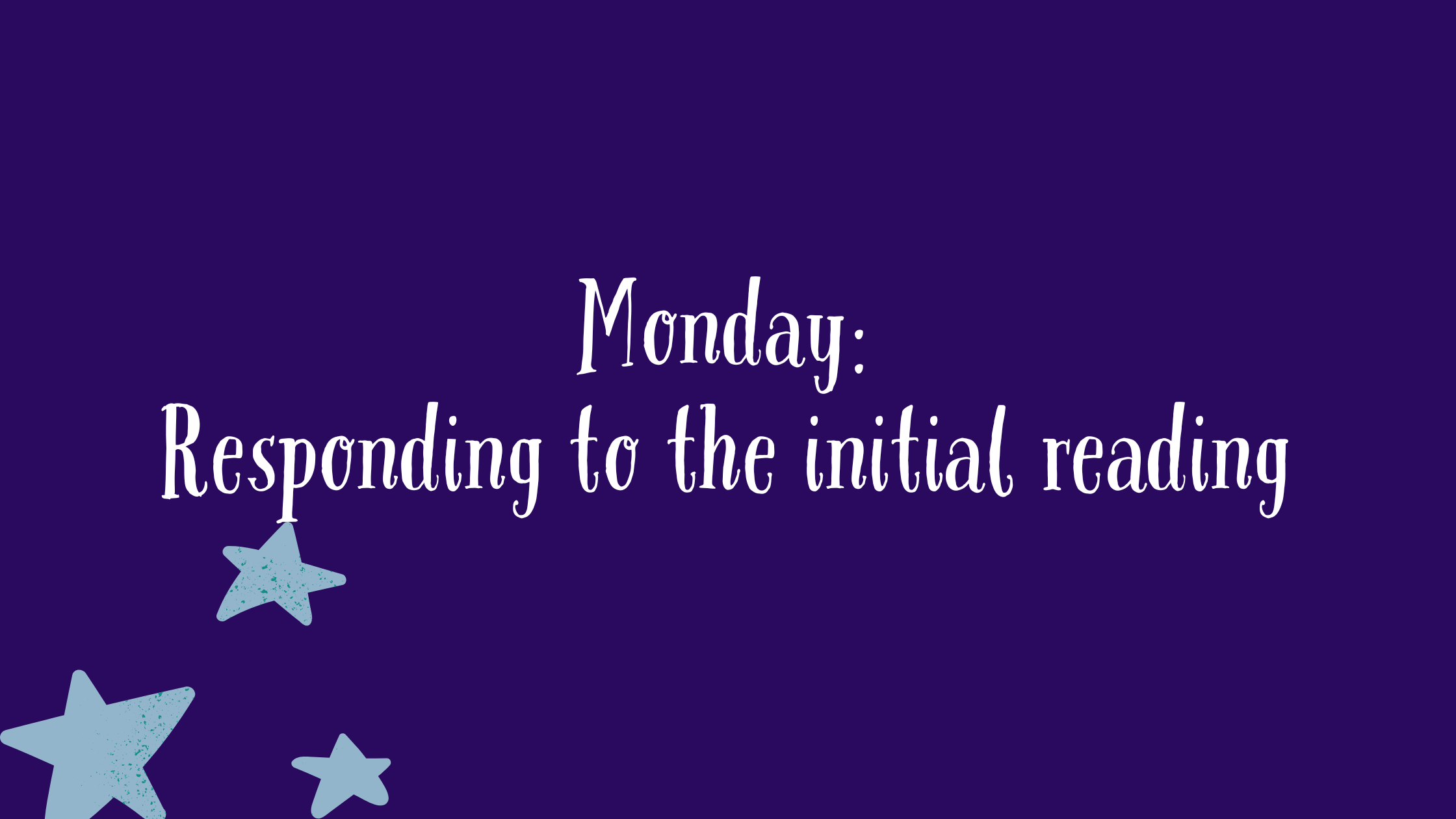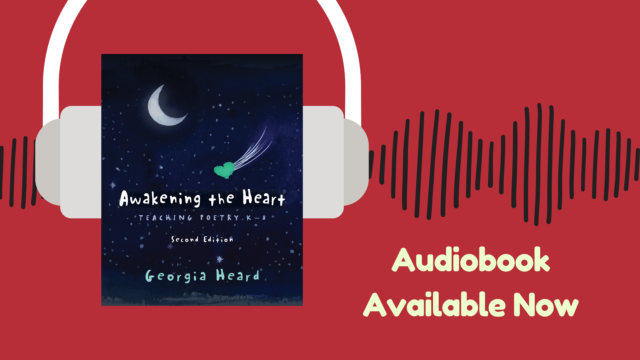
The following excerpt is from Georgia Heard's forthcoming Awakening the Heart: Teaching Poetry K-8, 2/e.
***
Living with a poem over multiple days is like making a friend; when you first read a poem, you might feel a little shy because it is unfamiliar, but as the days go by and you spend more time together, you discover that you understand each other, perhaps even have a lot in common, and you discover that the friendship has deepened.
How can we do a close reading of a poem and explore it over multiple readings and days without losing the energy, the initial excitement and freshness, of the experience of a poem?
The goal of closely reading a poem over multiple days is for students to fall in love with it by understanding it more deeply and intimately. You can use the strategies in this multiday reading plan with any poem, and like moveable furniture, you can rearrange them depending on students’ responses.
 Invite your students to close their eyes as they listen to the poem. After you’ve finished, let the silence that the poem creates linger for a few seconds. That silence allows readers to fully experience the poem. Read the poem a second time, then invite responses. Pose open-ended questions not about the poem’s content but about students’ connection to and understanding of the poem. Start with only one or two questions, as asking too many might disconnect students from the poem and make your discussion feel more like a quiz. You can also write a few of the questions on a chart and let students select which ones they want to discuss.
Invite your students to close their eyes as they listen to the poem. After you’ve finished, let the silence that the poem creates linger for a few seconds. That silence allows readers to fully experience the poem. Read the poem a second time, then invite responses. Pose open-ended questions not about the poem’s content but about students’ connection to and understanding of the poem. Start with only one or two questions, as asking too many might disconnect students from the poem and make your discussion feel more like a quiz. You can also write a few of the questions on a chart and let students select which ones they want to discuss.
- What do you understand about the poem?
- What do you notice about the poem?
- What does the poem make you feel?
- How do you relate to this poem (or how don’t you relate to it)?
- What images does the poem evoke? What pictures do you see in your mind?
Students’ conversation around a poem and their written responses in poetry notebooks will be wide-ranging—they might express what the poem means to them personally; experiences that the poem reminds them of; lines, images, and words that surprise or stand out; what they notice about the craft or form of the poem; questions they have; and parts, words, or lines they don’t understand, among other things. Their responses will guide your teaching for the next few days.
 On the second day, you can guide students to take a closer look at the poem and discuss how reading the poem again has changed their understanding. Based on their initial responses, choose one or two questions from this list to spark discussion:
On the second day, you can guide students to take a closer look at the poem and discuss how reading the poem again has changed their understanding. Based on their initial responses, choose one or two questions from this list to spark discussion:
- How did your understanding of the poem change from the first reading to the second?
- What do you think is important in the poem versus what the poet thinks is important? Is there a difference?
- What emotions does the poem evoke?
- What images does the poem create? (Encourage students to sketch the imagery in the margins of the poem or on a separate sheet of paper.) In what ways does visualizing the poem help with understanding?
- How do you relate to the poem, and how do you not relate?
- What questions do you have about the poem?
 To start Wednesday’s and Thursday’s reading and discussion of the poem, you can use some of the same questions mentioned earlier, depending on the students’ responses. For example:
To start Wednesday’s and Thursday’s reading and discussion of the poem, you can use some of the same questions mentioned earlier, depending on the students’ responses. For example:
- How has your understanding of the poem changed after reading it multiple times?
- What do you notice about the poem now that you didn’t notice before?
As the students gain a deeper understanding of the poem, they may begin to notice and ask questions about the poem’s craft features, such as specific word choices, punctuation, or form. It’s important to discuss these craft moves within the larger context of how they contribute to the poem’s meaning and experience. You can ask questions like these:
- What type of poem is it, and how does the form support the mood or message of the poem? Is it free verse or a specific form, such as haiku?
- What musical tools does the poem use, such as rhyme or repetition?
- Who is the speaker of the poem, and what is the poem’s perspective or point of view?
- Does the poem use metaphor or other literary devices to express a bigger idea?
- How does the poem’s use of white space, line length, and stanza structure influence your reading of the poem?
- What words or phrases stand out to you, and why?
While discussing these craft moves, make sure to connect them back to the meaning of the poem and how they contribute to it.
 On the final day of studying a poem, students can reflect on how their understanding of the poem has developed throughout the week and summarize what they have learned. Some students may have grown to love the poem, while others may not have connected with it as much. Students who appreciate the poem can make a copy to keep in their poetry notebooks or online folders.
On the final day of studying a poem, students can reflect on how their understanding of the poem has developed throughout the week and summarize what they have learned. Some students may have grown to love the poem, while others may not have connected with it as much. Students who appreciate the poem can make a copy to keep in their poetry notebooks or online folders.
In addition, students can engage in further exploration in any of the following ways:
- looking for other poems by the same poet
- writing their own poems inspired by the imagery, memories, words, phrases, or lines from the original poem
- comparing and contrasting the poem with another poem on a similar theme or topic or by the same poet, which can help deepen their understanding of both poems and identify common themes or stylistic elements
- performing the poem aloud or in small groups, using different voices and inflections to explore the nuances of the language and meaning
- researching the historical and cultural context of the poem, including the poet’s background and the social, political, or literary movements of the time, which can provide a deeper understanding of the poem’s themes and meanings
- creating multimedia projects inspired by the poem, such as videos, animations, or collages, helping them explore the visual and auditory dimensions of the poem and its themes
***
Listen to Georgia Heard on the Heinemann podcast discuss the forthcoming book.
Georgia Heard's best-selling resource for teaching poetry, now fully updated with new lessons, exercises, and writing prompts that engage today's kids.
Awakening the Heart, Second Edition released on March 19th.



